
Welcome to Alcat Cast Stone Art
At Alcat Cast Stone Art, we specialize in offering exquisite hand-painted and custom-poured art. Our passion lies in creating unique works of art that capture the essence of history, culture, and personal expression. With a diverse range of subjects and themes, including iconic figures like Jesus, Trump, General Lee, General Forrest, General Jackson, AP Hill, and Sally Thompson, as well as intricately crafted pieces such as Harley Davidson Motorcycles, benches, and the water man, our collection is a testament to our creativity and dedication.
Attention to detail and craftsmanship is evident in each piece. Whether you're drawn to the presence of historical figures or the timeless beauty of custom-poured designs, every artwork in our collection tells a story and invites you to become a part of it.
Experience the beauty and quality of Alcat Cast Stone Art. Each creation is more than just a decoration; it's a statement piece that adds depth, sophistication, and personality to any space. Explore our collection and discover the perfect masterpiece to adorn your home, office, or property.
Choose from A Variety of Designs
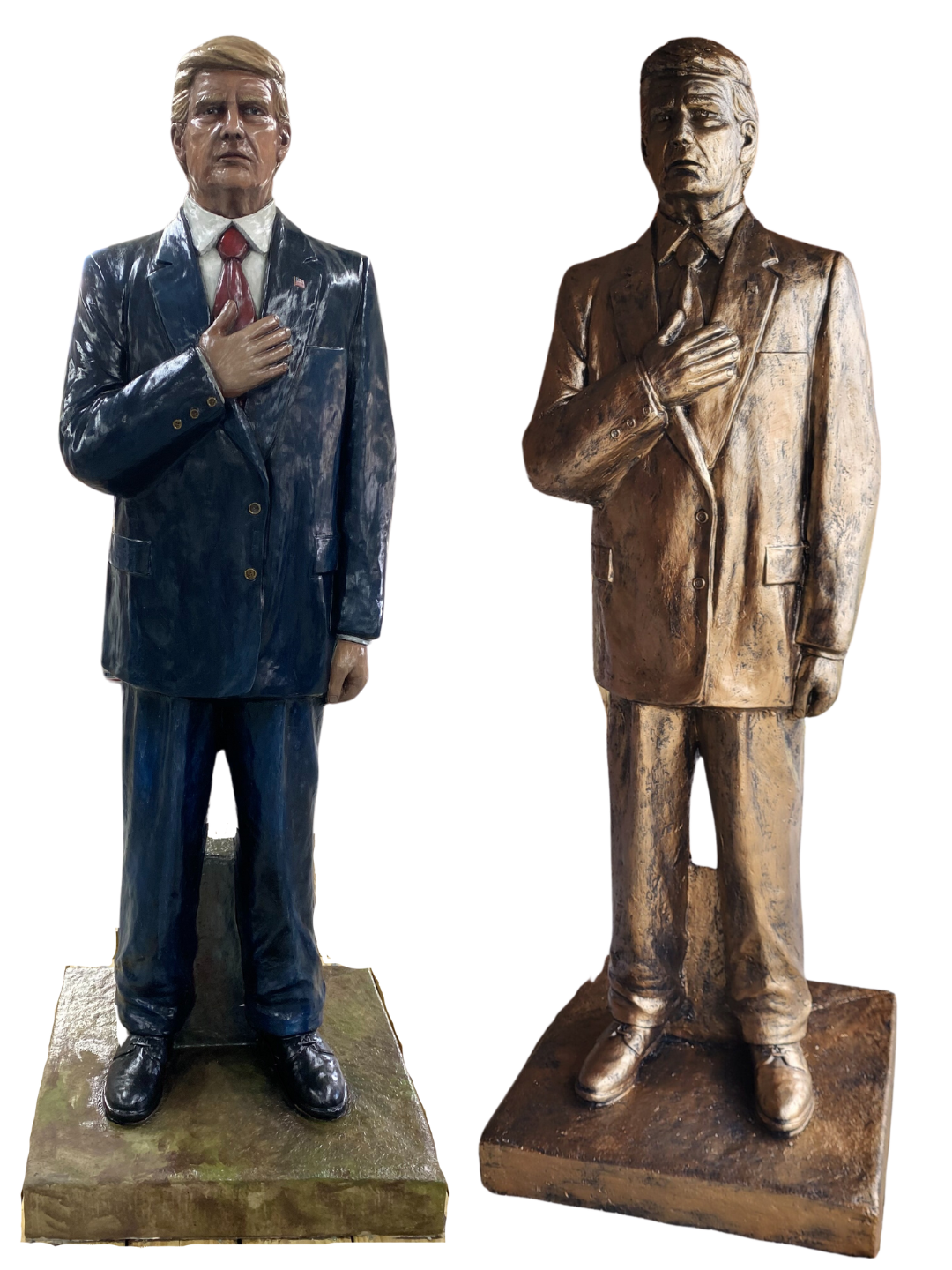
Donald J. Trump
Donald John Trump was born in Queens, New York, in 1946. He became a successful businessman with ventures in real estate, commercial properties, sports, vineyards, and a clothing line, and gained fame as the host of NBC’s “The Apprentice.” He surprised the world with his 2016 presidential candidacy, winning the election as the 45th President of the United States. During his tenure, Trump focused on rebuilding the military, border security, reducing regulations that hampered businesses, and achieved energy independence once again in the United States. His presidential tenure resulted in economic growth and record-low unemployment, among other things. Alcat Cast Stone Art is proud to offer a concrete-poured statue of Trump to commemorate his legacy.
General Ambrose Powel "A.P." Hill Jr.
General Ambrose Powell "A.P." Hill Jr., born in Culpeper, Virginia in 1825, was a distinguished military leader who served in both the Seminole and Mexican Wars. Joining the Confederate cause upon Virginia's secession from the Union, Hill commanded the 13th Virginia Infantry, known as the Light Division, despite its status as the largest division in Confederate armies. He demonstrated remarkable determination and leadership throughout the Civil War, notably at the Battle of Antietam, where he led his men in a grueling counterattack against Union forces. Hill's life tragically ended at the age of 39 at the Third Battle of Petersburg. To honor his legacy, consider ordering a statue of Powell, commemorating his resilience, determination, and unwavering leadership.
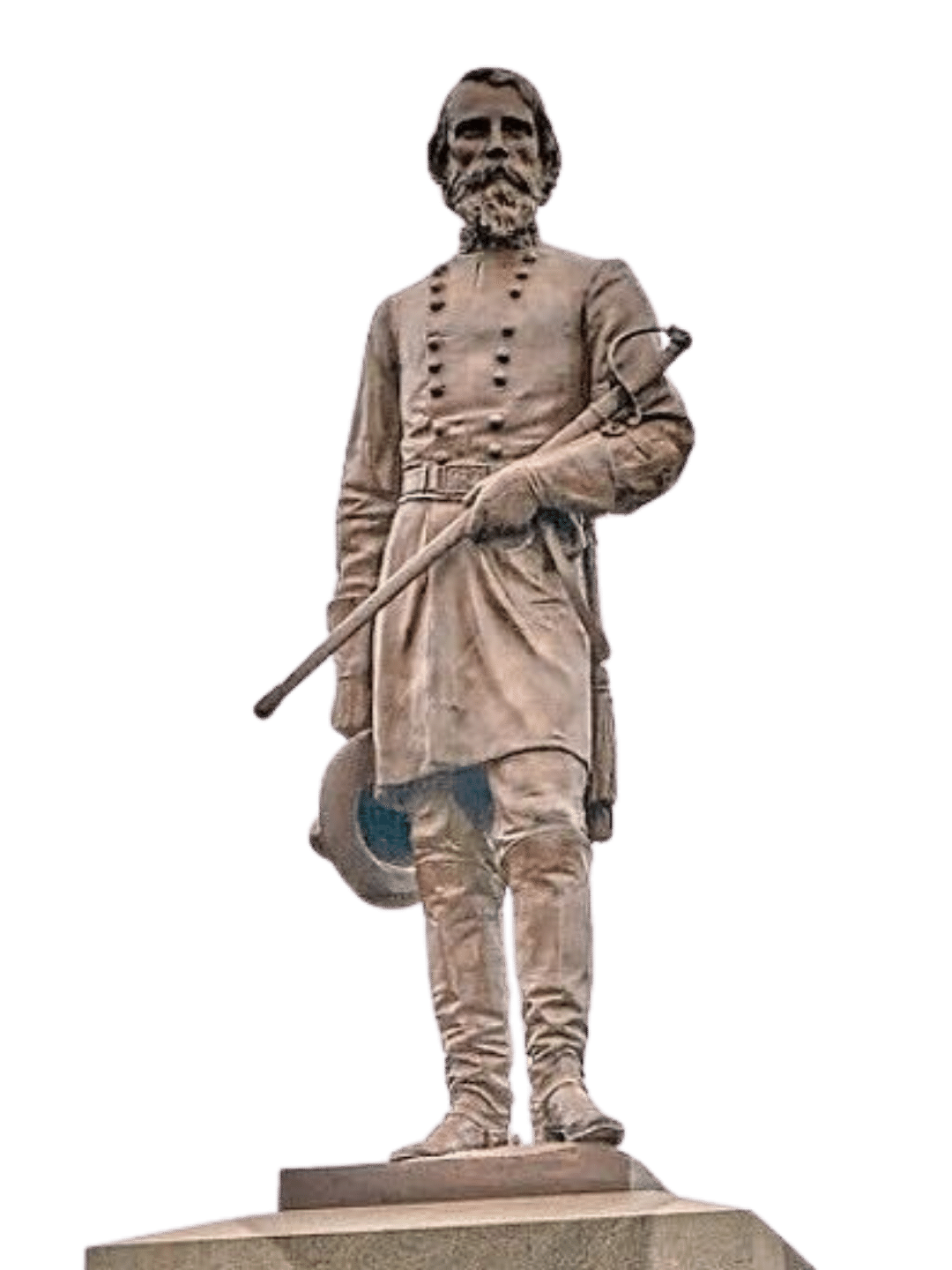

Sally Louisa Tompkins
Captain Sally Louisa Tompkins, renowned as the "Angel of the Confederacy," epitomized selfless dedication during the Civil War. Born in 1833, she transformed her inheritance into the Robertson Hospital in Richmond, Virginia, providing top-tier care to wounded Confederate soldiers. Despite challenges from Confederate authorities, her exceptional healing record earned her a historic commission as a captain in the Confederate States Army, a rare honor for a woman. Revered by soldiers as "Captain Sally," her hospital boasted an outstanding 94.5% survival rate, a testament to her compassion and resilience. Even after the war, she remained active in the Episcopal Church and continued to be revered by her former patients. Captain Sally's legacy endures through memorials and honors, embodying the enduring impact of selfless service and compassion.
Order Your Sally Louisa Tompkins Statue from Alcat Cast Stone Art
Robert E. Lee
Robert E. Lee, born January 19, 1807, in Virginia, emerged as the epitome of Confederate leadership during the Civil War. Son of a Revolutionary War hero, Lee excelled at West Point and served with distinction in the U.S. Army. Despite offers to lead Union forces, his allegiance to Virginia led him to command Confederate troops. Appointed head of the Army of Northern Virginia, Lee showcased his military brilliance, achieving victories despite being outnumbered, notably at Second Manassas, Fredericksburg, and Chancellorsville. The Battle of Gettysburg marked a turning point, followed by defensive actions in Virginia. Surrendering at Appomattox Court House in 1865, Lee's dignified demeanor earned him respect even from his Union adversaries. Later, as president of Washington College, Lee left a legacy of honor and leadership, remembered for his contributions to American history.
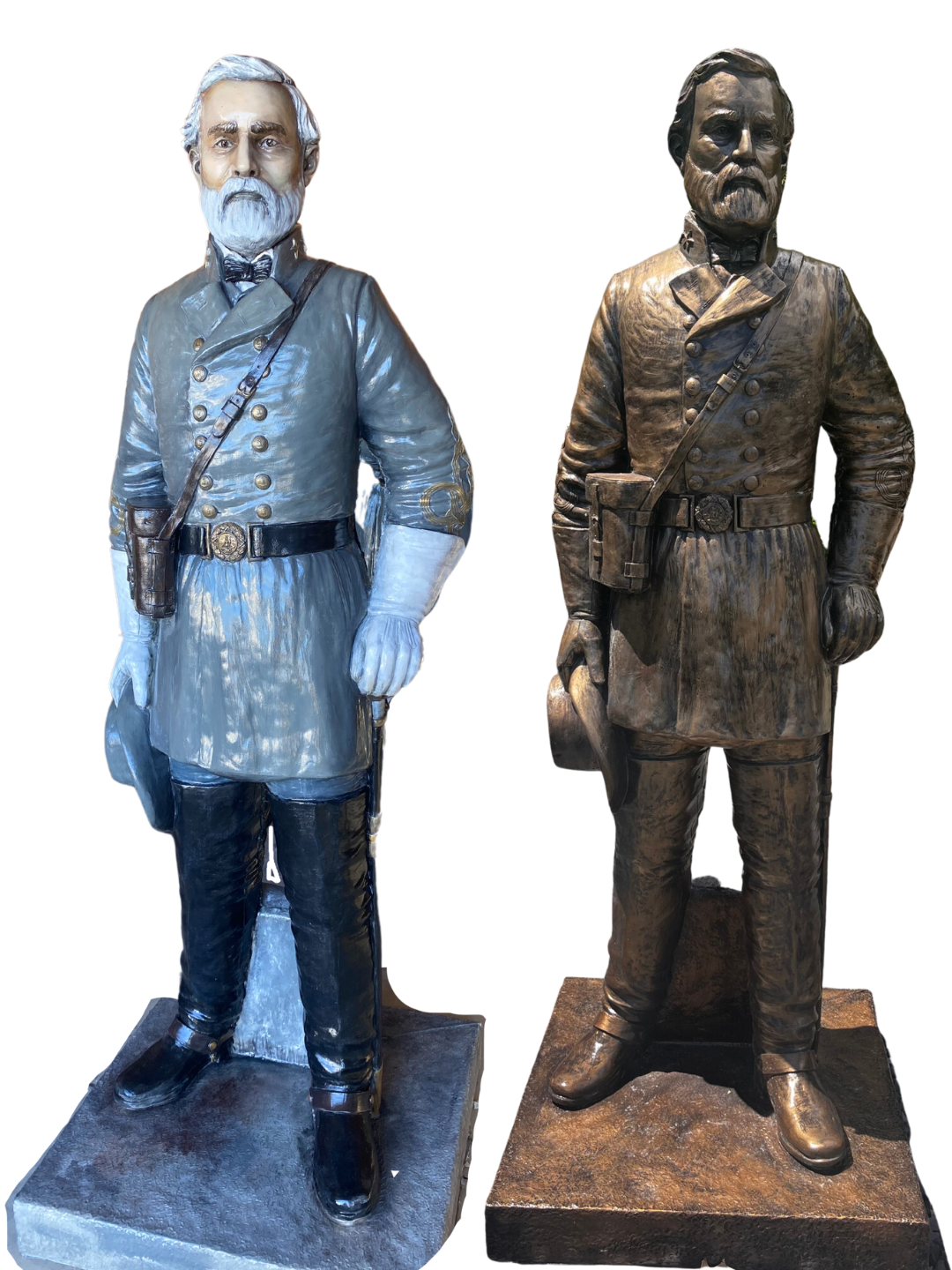

Nathan Bedford Forrest
Nathan Bedford Forrest, born on July 13, 1821, in Tennessee, emerged as one of the Confederacy's most renowned cavalry commanders, earning the moniker "wizard of the saddle." Despite limited formal education, Forrest's determination propelled him from humble beginnings to prominence as a planter and military leader. Joining the Confederate cause, he quickly rose through the ranks, demonstrating strategic brilliance and boldness in combat. Notable engagements include his daring escape from Fort Donelson and successful raids against Union forces. Forrest's legacy is complex, marred by controversies such as the Battle of Fort Pillow, yet marked by his post-war advocacy for civil rights. His historic speech promoting racial reconciliation remains emblematic of his desire for unity. Despite his death on October 29, 1877, Forrest's influence endured, evidenced by the diverse throngs of mourners at his funeral, reflecting the impact of his leadership and legacy.
Thomas "Stonewall" Jackson
Thomas "Stonewall" Jackson, born January 21, 1824, in Clarksburg, Virginia, was a renowned Confederate general. Graduating from West Point, he excelled in the Mexican-American War before joining the Virginia Military Institute as a professor. Jackson's military prowess earned him the nickname "Stonewall" for his steadfastness at the Battle of First Manassas. Notable for his Valley Campaign and role in key battles like Fredericksburg and Chancellorsville, his tactical brilliance was unmatched. Despite his military renown, Jackson's legacy extends beyond warfare. He challenged societal norms by teaching Sunday school to slaves and remains a figure of admiration, memorialized even in an African American church. Jackson's quotes reflect his unwavering faith and commitment to honor. He passed away on May 10, 1983, leaving behind a legacy of military excellence and moral integrity, commemorated alongside his wife, Mary Anna Morrison, in Lexington, VA.
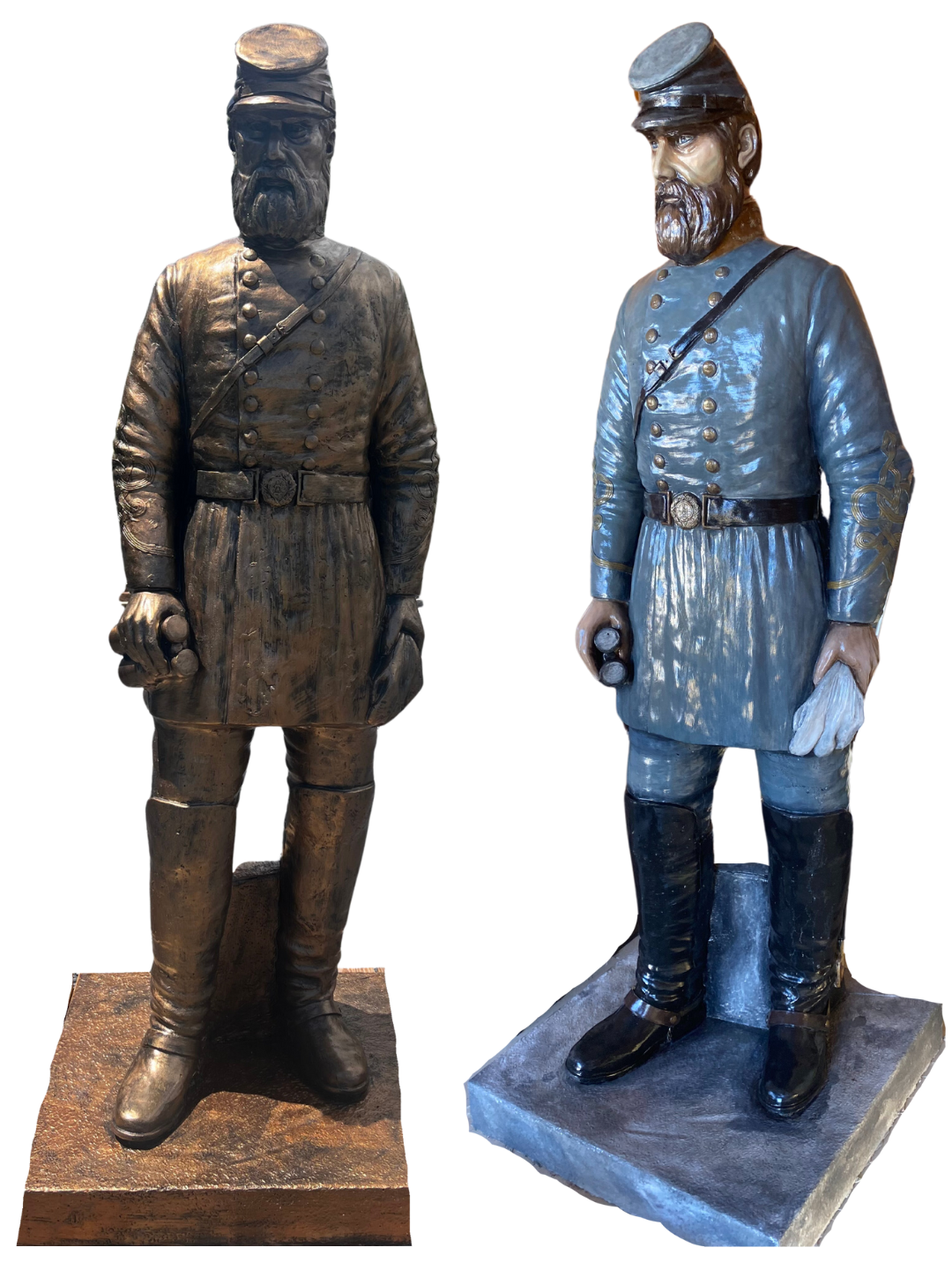
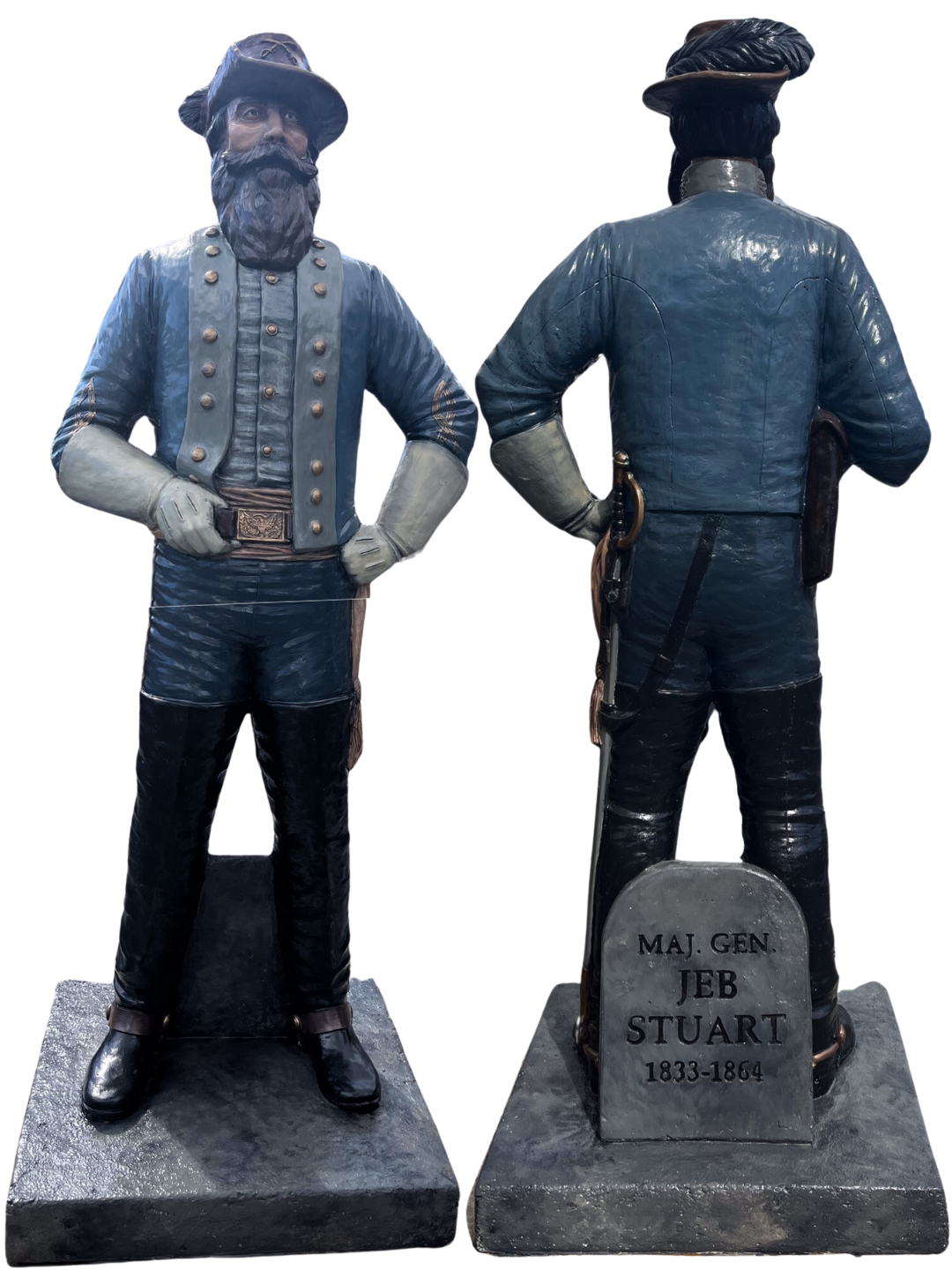
James Ewell Brown "JEB" Stuart
James Ewell Brown "JEB" Stuart, born February 6, 1833, at Laurel Hill Farm in Virginia, rose to prominence as one of the Confederacy's finest cavalry commanders. Graduating from West Point, he served in the US Army before joining the Confederate cause at the outbreak of the Civil War. Stuart played pivotal roles in numerous battles, including the First Battle of Bull Run and the Peninsula Campaign, earning admiration for his daring exploits. Despite criticism for his actions at Gettysburg, his leadership remained invaluable to the Confederate cause. Stuart's untimely death at the Battle of Yellow Tavern on May 12, 1864, marked a significant loss to the Confederate army, mourned by General Robert E. Lee and remembered for his valor and devotion. Today, his legacy lives on in his military achievements and enduring impact on Civil War history.
Jesus
Crafted with meticulous attention to detail and profound symbolism, this statue captures the essence of Jesus Christ, embodying His earthly ministry and eternal divinity. Central to its depiction is the Most Sacred Heart of Jesus, symbolizing God's infinite love and compassion for humanity.
Intricately designed, the Sacred Heart radiates divine light, symbolizing Christ's fervent love and sacrifice. Every detail, from the pierced hands to the crown of thorns, speaks to the significance of His life, death, and resurrection.
Whether placed in sacred spaces or homes, the Jesus Christ Statue serves as a powerful reminder of faith and devotion, inspiring hearts for generations to come.
Order Your Bronze or Hand Painted Statue of Jesus Christ Today

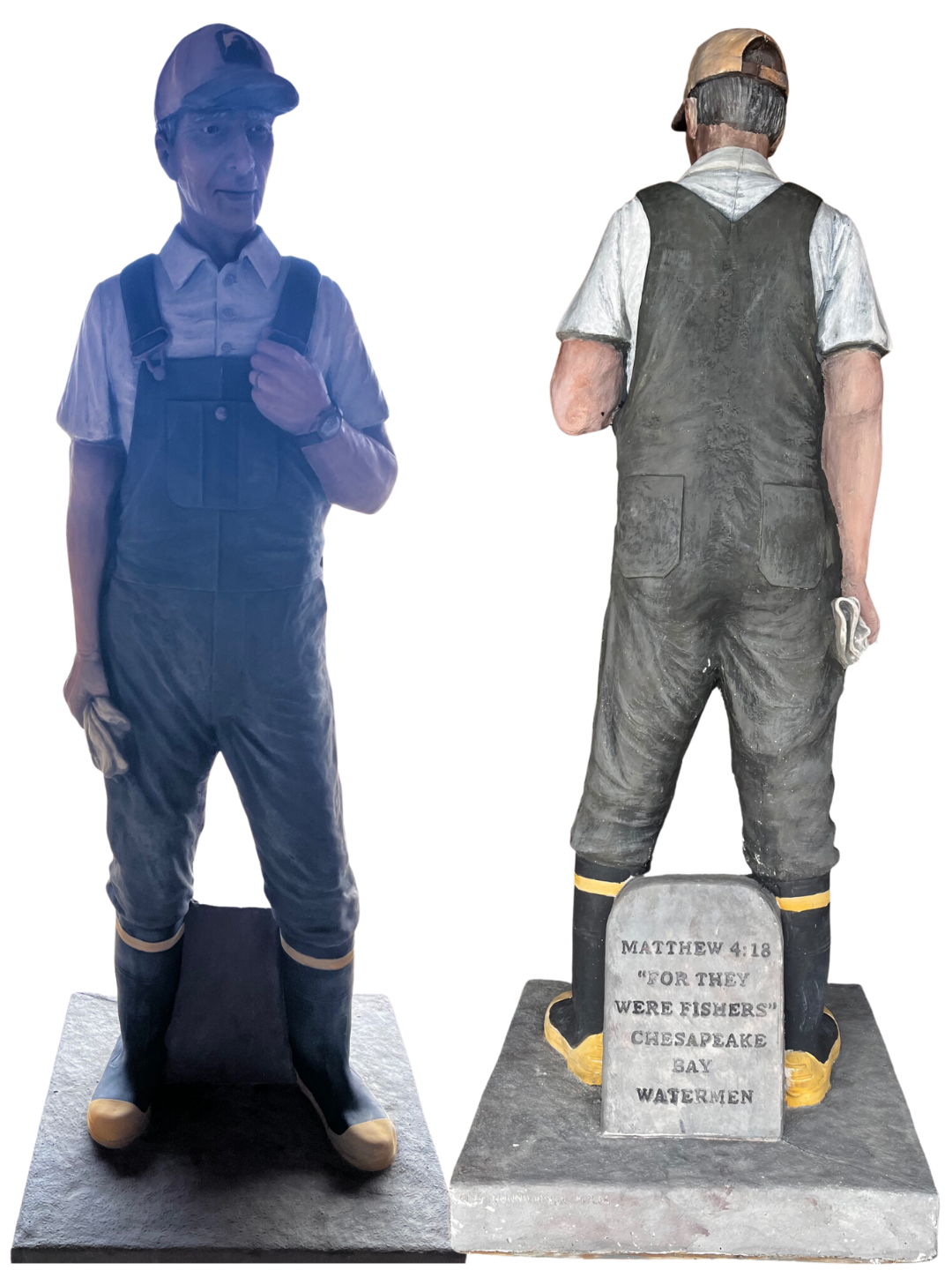
Chesapeake Bay Watermen
The Chesapeake Bay Watermen are a resilient and enduring group whose lives and livelihoods are deeply tied to the waters of the Chesapeake Bay. Known for their centuries-old traditions of fishing, crabbing, and oystering, these watermen harvest blue crabs, oysters, clams, and fish using traditional methods refined over generations. Their work, which begins before dawn in deadrise boats designed for the bay's unique conditions, is physically demanding and shaped by the rhythms of the seasons, tides, and sustainability regulations. Despite challenges like declining oyster populations and pollution, the watermen's intimate knowledge of the bay and their commitment to preserving its resources reflect a deep connection to both their heritage and the natural world. They embody a spirit of perseverance and adaptability, ensuring that their storied way of life and the bay's bounty endure for future generations.
V-Twin Bench
Introducing the V-Twin Bench—a masterpiece that combines the thrill of the open road with the comfort of a stylish and functional bench. Crafted with a passion for the motorcycle lifestyle, this bench is more than just a seat; it's a tribute to the spirit of freedom and adventure.
"Live to ride - Ride to live" is the motto engraved on this unique piece, embodying the essence of the biker's journey. The bench features Knucklehead 74" (1936-1947) engine heads, a nod to one of the most iconic engines in motorcycle history. These benches are perfect for anyone who appreciates the artistry and engineering of classic motorcycles.
Whether you're a dedicated rider or simply an admirer of vintage motorcycle culture, the V-Twin Bench brings a touch of that world into your space, making it the ultimate addition to your home, garage, or patio.
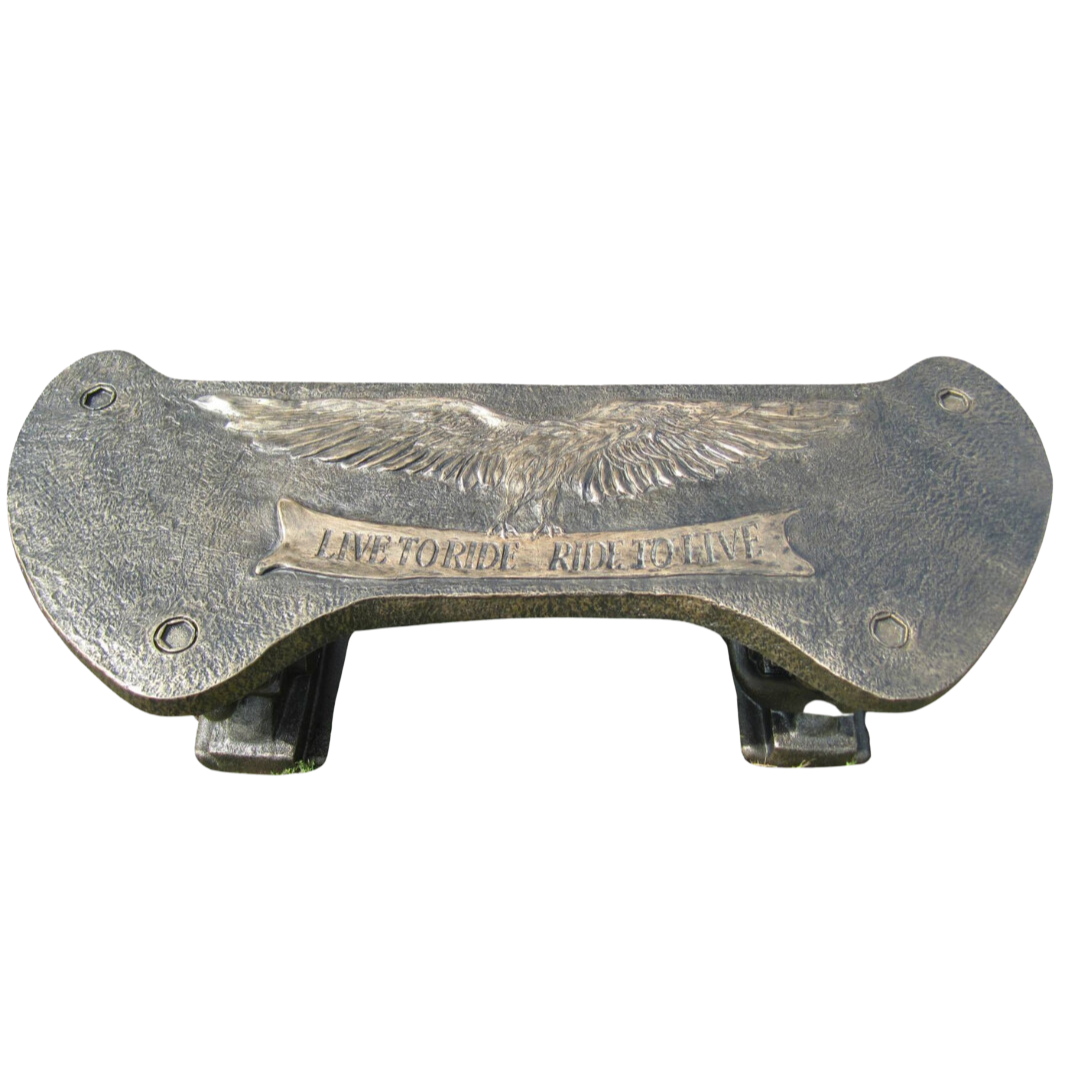
Additional Concrete Custom-Poured Possibilities
- Harley Davidson Motorcycle
- Benches
Additional History of Our Statued Figures
Read more about the lives and legacies of the various individuals we memorialize in statue form.
Contact Us Today About A Custom Poured and Hand Painted Statue from Alcat Cast Stone Art
Read More About Alcat Cast Stone Art's Featured Historical Figures
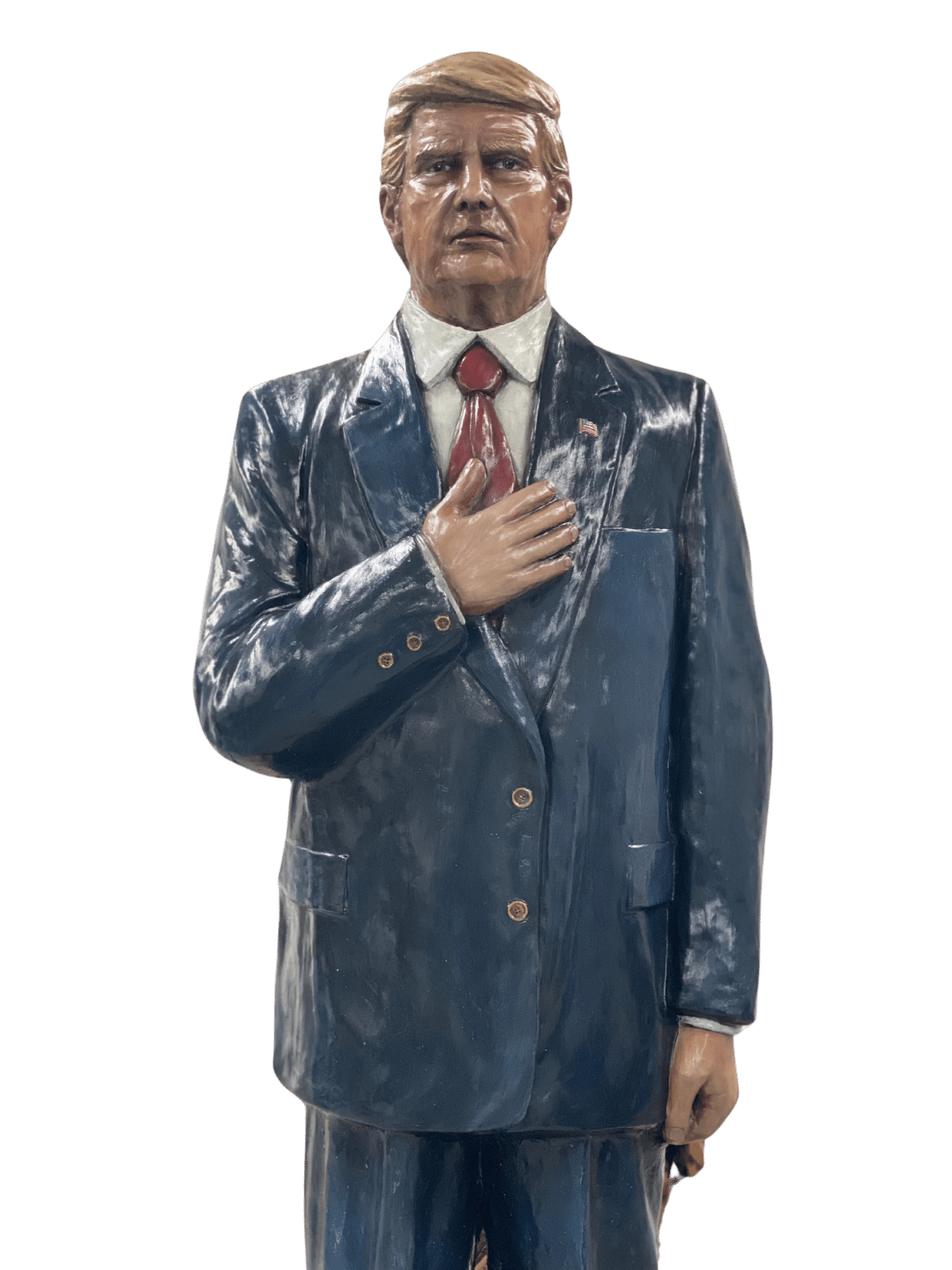 Donald John Trump was born on June 14, 1946, in Queens, New York, to parents Fred Trump and Mary Anne MacLeod. He is a graduate of the University of Pennsylvania. Trump married Melania Knavs in 2005, and they have a son named Barron. Additionally, Trump has four other children: Don Jr., Ivanka, Eric, and Tiffany. Despite facing challenges, Trump has achieved considerable success as a businessman with diverse holdings and ventures, including real estate, commercial properties, owned a USFL football team (which gained major attention with the drafting and signing of star player Herschel Walker), vineyards and a winery, a clothing line, and various other ventures.
Donald John Trump was born on June 14, 1946, in Queens, New York, to parents Fred Trump and Mary Anne MacLeod. He is a graduate of the University of Pennsylvania. Trump married Melania Knavs in 2005, and they have a son named Barron. Additionally, Trump has four other children: Don Jr., Ivanka, Eric, and Tiffany. Despite facing challenges, Trump has achieved considerable success as a businessman with diverse holdings and ventures, including real estate, commercial properties, owned a USFL football team (which gained major attention with the drafting and signing of star player Herschel Walker), vineyards and a winery, a clothing line, and various other ventures.
Trump gained further notoriety as the host of NBC’s reality TV show, “The Apprentice.” Throughout his years as a well-known public figure, he was involved in supporting various politicians and candidates in several parties.
In a surprising turn of events, Trump announced his candidacy for President in 2016, ultimately winning the election and becoming the 45th President of the United States of America. During his presidential tenure, Trump prioritized initiatives such as rebuilding the military, constructing a wall on our southern border, reducing regulations that hampered businesses, and increasing domestic energy production making the United States energy independent for the first time in decades.
These and other policies contributed to record growth in the stock market, low interest rates, increased domestic investment, and the return of some manufacturing jobs to US soil. Our economy was growing in leaps and bounds not seen in years! Citizens saw lower energy costs, record-low unemployment, and tax cuts for the working class and others. Trump
Under his administration, there were record low unemployment rates, with notable decreases in Black unemployment. Trump delivered on campaign promises one after the other, more so than any president in modern history resulting in many people believing in his iconic slogan, “Make America Great Again.” The United States and its people should always be the first priority, for their ability to prosper and be safe, with law and order enforced and criminals prosecuted, ultimately keeping citizens safe!
Trump's Political Affiliations Over Time:
- Republican: 1987-1999
- Reform Party: 1999-2001
- Democrat Party: 2001-2009
- Independent: 2011-2012
- Republican: 2012-Present
For those interested in commemorating Donald Trump's legacy, contact Alcat Cast Stone Art for a concrete-poured statue of Trump. Celebrate the achievements and contributions of this iconic figure with a timeless piece of art. Order today!
General Ambrose Powell "A.P." Hill Jr., known as Powell to his family and friends and as Little Powell to his troops, was born in Culpeper, Virginia on November 9, 1825. He entered the Military Academy at West Point in 1842 but missed a year due to illness, ultimately graduating as a member of the Class of 1847.
Hill served in both the Seminole and Mexican Wars. Upon Virginia's secession from the Union, he resigned his commission with the Union Army and accepted one in the Confederacy as a Colonel.
He commanded the 13th Virginia Infantry, which he dubbed the Light Division despite it being the largest division in the Confederate armies. Hill sought to establish his men’s reputation for speed and agility with this seemingly contradictory name. One of Hill's soldiers remarked after the war, "The name was applicable, for we often marched without coats, blankets, knapsacks, or any other burdens except our arms and haversacks, which were never heavy and sometimes empty."
Throughout the war, Hill demonstrated determination, character, and leadership. One particular battle highlighted his abilities: Sharpsburg, Maryland (Antietam). Despite his Light Division being left behind to process Union prisoners at Harpers Ferry, Hill responded to an urgent dispatch for assistance from Lee. He led his men on a grueling march of nearly 20 miles, including fording the Potomac River, and arrived just in time to counterattack a strong forward movement by the corps of Maj. Gen. Ambrose Burnside. Hill and his men helped neutralize the threat to Lee’s right flank, bringing an end to the battle. Lee's army emerged battered yet undefeated, a testament to the grit and determination displayed by Hill and his troops.
Hill met his end on April 2, 1865, at the Third Battle of Petersburg. He and one of his officers rode out in front of their lines to demand the surrender of a Union unit, but Hill was fatally shot through the chest by one of the Federals and died within moments. He was only 39 years old and died just seven days before Lee’s surrender.
Hill's family included his wife Catherine Morgan Hill, also known as Kitty or, as Hill affectionately called her, Dolly, and their children: Henrietta, Frances Russell, Lucy Lee (whose godfather was Robert E. Lee), and Ann Powell.
To commemorate the legacy of General Ambrose Powell "A.P." Hill Jr., order a statue of Powell from our collection. Celebrate the resilience, determination, and leadership displayed by this remarkable figure in American history.
 From her birth in 1833 at Poplar Grove, her family’s Mathews County estate in Virginia’s Tidewater region, Sally Louisa Tomkins was raised in a family who served their state or country. One grandfather had been brevetted by Washington at Monmouth. Another had been a naval officer. Her father had been a militia colonel.
From her birth in 1833 at Poplar Grove, her family’s Mathews County estate in Virginia’s Tidewater region, Sally Louisa Tomkins was raised in a family who served their state or country. One grandfather had been brevetted by Washington at Monmouth. Another had been a naval officer. Her father had been a militia colonel.
If in, say, the spring of 1861, you had been in Richmond, and Judge John Robertson had presented you to Miss Sally Louisa Tompkins, you would have found the twenty-seven-year-old lady diminutive. Lately from "Poplar Grove" in Mathews County - her mother, her sister, and she had moved to the capital following her father's death -, she was no taller than five feet and was slim, brunette, and plain of feature. "Miss Sally," you might later have remarked to the judge, "was not designed by Nature for hard labor." If so, he would have told you that you were wrong. Much of her life had been spent in lightening the burdens of others and in ministering through endless hours to the sick. She could work like a Trojan.
"But since she cannot herself be a soldier, Judge," you might have replied. "And since, as you tell me, she is well-to-do, I suppose she finds other outlets for her energies. Probably loves parties. Or, though she was quite simply dressed, she may be fond of rich apparel. And I suppose she's widely travelled."
Wrong again! Miss Sally's tastes were otherwise. In addition to an interest in nursing, a religious nature led her to a constant study of the Scriptures and to much work in her beloved Protestant Episcopal Church. Travel she would, yes, anywhere, so long as it is to the side of a sick bed or to a church conference. But so far as travel for its own sake was concerned, no one could remain more contentedly at home than she.
Reportedly, from early childhood she showed both an inclination and an aptitude for nursing, and in the immediate aftermath of the First Battle of Manassas in late July 1861, she determined to dedicate her inheritance—and her life—to the care of Confederate wounded.
Tompkins was offered use of the home of Circuit Court Judge John Robertson, at the corner of 3rd and Main streets. She immediately bought medical supplies and outfitted what she named the Robertson Hospital in top-drawer fashion. Tompkins staffed the hospital with women—all fellow members of the St. James Episcopal Church—who called themselves, appropriately, the “Ladies of Robertson Hospital.” Mrs. Robertson insisted that the furniture stored upstairs be rearranged and used. It was, and the capacity of the house was thereby increased to hold twenty-five beds.
Yet a hitch was to ensue. The Confederate government was soon inclined to view the decentralized, private hospital system. Determined there was need for rigorous control of medical and surgical supplies in a land in which they were not plentiful. And most certainly there was need for better regulation of the flow of sick and injured military personnel. One would blush to confess it, but even in the gray and butternut legions there were malingerers ("gold bricks" is modern army jargon) who, if allowed to do so, would have made a career of remaining hospitalized. As for their tender-hearted, self-appointed nurses, they, it was believed, were too inclined to be sympathetic with feigned aches and pains. Accordingly, an order was issued closing all private hospitals to soldiers and directing that uniformed patients be sent only to those operated by the government.
It is recorded that, upon receiving this directive, Miss Sally wept; But not for long. As to how she won her point, and she usually did, stories vary. A daughter of Judge William W. Crump, the Confederate Assistant Secretary of the Treasury, stated that he and Sally personally went to call on President Davis. The tiny nurse presented her infirmary register to the statesman. It proved to him that so superior was her record of healing men and returning them to the ranks that it could not be matched by that of any other hospital, whether government or private.
Mr. Davis was visibly impressed. A government regulation must be obeyed, of course, but . . . . He paced the floor thoughtfully. Then he stopped short and, facing bliss Sally, said, "I will make you a captain in the army of the Confederate States. In that way your hospital can be saved."
At any rate, it is undeniable that dated as of September 9, 1861, a commission was sent to Sally Tompkins, who was addressed as "Sir." She was also informed that her branch of service would be the cavalry, unassigned, with commensurate rights and claims to pay. The masculine salutation is explicable: in all modern military history to that time there was no regularly-commissioned captain known who had not been a man. And it has been suggested that she was listed as being in the cavalry because a captaincy in that branch entitled her to more pay (she was expending generously of her own funds on her hospital) than in any other. The emolument of rank she never accepted, however, requesting that it be employed for the benefit of the common soldiers. "I was too anxious to help them," she later explained, "to take anything from them."
Her unprecedented commission was to stand alone in American military annals until women were made eligible for officer rank in the Army Nurse Corps of the United States Army in 1901. It is of further interest to find that prior to the establishment of the Women's Army Auxiliary Corps in World War II federal authorities procured and studied copies of the commission of Captain Sally Tompkins, C. S. A., who had continued to be referred to or addressed by her military title to the end of her days.
She also demonstrated considerable grit in confronting threats to her institution. In June 1864, a Confederate military inspector of hospitals named Carrington took it as his mission to close down the Robertson Hospital, claiming that it was filled beyond capacity. In response, Tompkins wrote to the authorities that his assertion of overcrowding “was written under a misapprehension of the facts,” adding, “I think the register of this Hospital will show as great success in its management of the sick and wounded as any other. Since the 1st of last June, we have had 337 patients and but 8 deaths. Many of them sent to us were…the worst cases.” Needless to say, the hospital remained open.
The soldiers adored Tompkins, dubbing her “the Angel of the Confederacy,” “the Little Lady with the Milk-White Hands,” and most commonly, “Captain Sally.” One source records that she “saw that every discharged patient received clean clothes, rations, and a Bible.” Love-struck patients often asked for her hand in marriage, but she always refused, commenting, “Poor fellows, they are not yet well of their fevers.”
The 94.5 percent survival rate at Tompkins’ hospital in Richmond was the best for any comparable facility on either side during the war. (Virginia Museum of History and Culture) At war’s end, Tompkins kept her doors open, releasing her last patient on June 13, 1865—two months after Robert E. Lee’s surrender at Appomattox. Although most of the Confederacy’s records in Richmond were burned, one statistic remains indisputable: During its 45 months in operation, the Robertson Hospital treated 1,333 soldiers and lost only 73, reflecting a survival rate of 94.5 percent. This is a remarkable record, especially considering the time and conditions.
After the war, Captain Sally remained active in the affairs of the Episcopal Church and enjoyed a certain celebrity as a frequent guest at reunions and other functions. Between June 30 and July 2, 1896, the Grand Confederate Reunion took place in Richmond. As part of the observances, a reunion of Tompkins’ former patients was held at the hospital. Several old soldiers attended and were once again treated to the solicitousness of their former nurse. According to the historical records at the Library of Virginia, to mark the occasion, “Sally Tompkins rented a house and provided food and drink for former patients of Robertson Hospital and their families.”
Captain Sally never married, despite the many proposals from her grateful and adoring patients. In 1905, therefore, on behalf of the board of managers of the Richmond Home for Confederate Women, the wife of Governor Andrew J. Montague asked her to honor them by becoming their lifetime "guest.'' She accepted, but only on the condition that she be allowed to pay for her own expenses.
With trembling eagerness, the aging women in the home welcomed to their midst the idolized Virginia heroine. They treated her with special deference from the beginning and assigned to her, noted an observer, as much respect as they might any other officer; A Small wonder; that is what she had been.
Death came to Sally Louisa Tompkins on July 25, 1916. Four United Daughters of the Confederacy chapters have been named in Sally Tompkins’ honor, and there is a memorial to her in the Mathews Court House Square.
At St. James Episcopal Church in Richmond, to which she dedicated so much of her time and resources, a stained-glass window features a full-size portrait of her holding a Bible and dressed in black, standing before an angel with arms extended protectively—a fitting tribute to the Angel of the Confederacy.
What has to be the most improperly represented General of the War Between the States; Nathan Bedford Forrest, the “wizard of the saddle,” was one of the finest Confederate cavalry commanders and one of the foremost military figures produced by the state of Tennessee. He was particularly famous for his determination to be “first with the most men.”
He was born in Chapel Hill, Tennessee, on July 13, 1821. He assumed responsibility for his family at the age of sixteen, following the death of his father. Despite a mere six months of formal education, Forrest rose from semi-subsistence to planter status, acquiring substantial property and wealth, largely through the slave trade.
When Tennessee seceded from the Union, Forrest enlisted as a private in Captain Josiah White’s Tennessee Mounted Rifles (Seventh Tennessee Cavalry), along with his youngest brother and fifteen-year-old son. Shortly afterward, Governor Isham G. Harris authorized him to raise a regiment of mounted troops. Forrest recruited and equipped his command, generally at his own expense. In December 1861, in his first major combat experience at Sacramento, Kentucky, Forrest demonstrated the traits of common sense tactics and close-hand fighting that would characterize his military career.
In February 1862 Forrest established a reputation for boldness when he led his men out of Fort Donelson rather than surrender. Elected colonel, he led his command at Shiloh, where he was wounded during the Confederate retreat. Subsequently, Forrest won promotion to brigadier general after a daring raid against a Union outpost at Murfreesboro in July 1862.
In mid-December 1862 Forrest led a raid into West Tennessee that destroyed Union supplies and disabled miles of track and trestlework. The Confederates eluded pursuit until forced into a pitched battle at Parker’s Crossroads on December 31. With the battle almost won, a second Union force appeared, and Forrest was fortunate to save most of his force. Nevertheless, he succeeded in crippling the supply lines over which General U. S. Grant had hoped to support his initial operations against Vicksburg, Mississippi.
On February 3, 1863, Forrest’s command suffered a defeat at Dover, Tennessee, while under the command of Major General Joseph Wheeler. Then, following redeeming victories at Thompson’s Station and Brentwood that spring, he stopped a Union raid led by Colonel Abel Streight through northern Alabama in April and May 1863. In his final confrontation with Streight, the Confederate cavalryman manipulated his forces magnificently, convincing the Federals to surrender their numerically superior forces by artificially inflating his own command.
Forrest participated in the retreat from Middle Tennessee led by General Braxton Bragg known as the Tullahoma Campaign. In the wake of the Confederate victory at Chickamauga, he urged but failed to convince, Bragg to pursue the defeated Federals. Resentful of Bragg’s ineptitude and earlier treatment of him, the fiery cavalryman bitterly denounced his superior officer.
He obtained a transfer to an independent command in Mississippi and for the third time in his military career created a new command of recruits and conscripts around a nucleus of battle-tested veterans. Promoted to major general on December 4, 1863, Forrest conducted raids against Federal communications and supply lines in Tennessee. In April 1864 he captured Fort Pillow, north of Memphis. In the latter stages of that battle, Forrest lost control of his men. As members of the black and Tennessee Unionist garrison attempted to surrender, an act for which they should have been spared, some of Forrest’s men fired on them. Of the fort’s 585-605 men, between 277 and 297 were killed; 64 percent of these were U.S. Colored Troops. Charges of a “Fort Pillow Massacre” became grist for Northern propaganda mills during the war and plagued Forrest for the remainder of his life.
Retired Confederate General Nathan Bedford Forrest was an outspoken advocate for the civil rights of the freedmen in postwar Tennessee. This advocacy and his popularity with the Memphis black community were resented by some of his white contemporaries who spread false rumors to discredit the general and further their own political interests.
Shortly after the end of the War Between the States and while Memphis was still under U.S. military command, Forrest spoke to the federal authorities regarding the former slaves within their command. He noted that many of the freedmen were skilled artisans and should be employed.
Additionally, he urged the authorities to establish training programs for the younger blacks, so the next generation would not be dependent.
Forrest also approached the Memphis Board of Aldermen, according to newspaper accounts, and argued that the black citizens could be doctors, clerks, bankers, or anything else if given the opportunity and education. He believed that the blacks were a part of the community and should be involved and employed like anyone else.
Although his words to the federal authorities and the city aldermen went unheeded, Forrest conducted his own business consistent with what he urged upon others.
As president of the Selma, Marion & Memphis Railroad, he employed former slaves as construction engineers, crew foremen, train engineers, and conductors. Blacks were hired as managers, as well as laborers.
In 1875, Forrest was invited to address a meeting of the Independent Order of Pole Bearers, an early black civil rights organization in Memphis, at its Fourth of July barbecue.
Although told by several whites that he should not participate, Forrest accepted the invitation. Just before he spoke, Forrest was presented a bouquet of flowers by the daughter of a Pole Bearers' officer. The gathering was at the Memphis fairgrounds, and Forrest's short, extemporaneous speech was reprinted in the Memphis newspaper, as follows:
"Ladies and Gentlemen, I accept the flowers as a memento of reconciliation between the white and colored races of the Southern states. I accept it more particularly as it comes from a colored lady, for if there is anyone on God's earth who loves the ladies I believe it is myself. (Immense applause and laughter.)
"I came here with the jeers of some white people, who think that I am doing wrong. I believe I can exert some influence and do much to assist the people in strengthening fraternal relations and shall do all in my power to elevate every man, to depress none. (Applause.)
"I want to elevate you to take positions in law offices, in stores, on farms and wherever you are capable of going. I have not said anything about politics today. I don't propose to say anything about politics.
"You have a right to elect whom you please, vote for the man you think best, and I think, when that is done, you and I are freemen. Do as you consider right and honest in electing men for office.
"I did not come here to make you a long speech, although invited to do so by you. I am not much of a speaker, and my business prevented me from preparing myself. I came to meet you as friends and welcome you to the white people.
"I want you to come nearer to us. When I can serve you I will do so. We have but one flag, one country; let us stand together. We may differ in color, but not in sentiment.
"Many things have been said about me which are wrong, and which white and black persons here, who stood by me through the war, can contradict."Go to work, be industrious, live honestly and act truly, and when you are oppressed I'll come to your relief. I thank you, ladies and gentlemen, for this opportunity you have afforded me to be with you, and to assure you that I am with you in heart and in hand." (Prolonged applause.)
After the speech, Forrest thanked the young black woman for the bouquet and kissed her on the cheek. This public familiarity between the races was unheard of at the time.
In his speech, Forrest referred to "black persons here who stood by me through the war." Apparently in the crowd were some of the cavalrymen who served in his command.
When Forrest's cavalry surrendered in May 1865, sixty-five blacks were on Forrest's muster role, including eight in Forrest's personal Body Guards, the general's handpicked elite inner circle. At the war’s beginning, Forrest told his slaves the following, ‘If they win the war they may free you. Come with me and I’ll free you!”
Commenting on the performance of his black soldiers, Forrest said: "Finer Confederates never fought."
Forrest established a reputation as one of the greatest cavalry generals of the Civil War. His ferocity as a warrior was almost legendary. His claim to have slain one more enemy soldier in personal combat than the twenty-nine horses killed beneath him only added to the legend. Forrest understood, perhaps better than most, the basic premise of war: “War means fighting and fighting means killing.”
When Forrest died on October 29, 1877, Memphis newspapers reported that his funeral procession was over two miles long. The throng of mourners was estimated to include over 3,000 black citizens of Memphis.
In 1845, Forrest married Mary Ann Montgomery (1826–1893), and they had two children, William Montgomery Bedford Forrest (1846–1908), who enlisted at the age of 15 and served alongside his father in the war, and a daughter, Fanny (1849–1854), who died in childhood.
Robert E. Lee was born on January 19, 1807, in Stratford Hall, Westmoreland County, Virginia. His father U.S. Col. Henry (“Light-Horse Harry”) Lee, had been a cavalry leader during the American Revolution, a post-Revolution governor of Virginia, and the author of a popular congressional memorial eulogy to his friend George Washington.
General Robert E. Lee ranked as the leading iconic figure of the Confederacy. Lee, Robert graduated from the United States Military Academy at West Point in 1829, ranking second in a class of forty-six—and without a single demerit. His prewar record as an officer was distinguished by numerous engineering projects, service in the Mexican War, and nearly three years as commandant at West Point.
In March and April 1861, Lee was offered command of the principal Union Army. Yet, after Virginia seceded on April 17, he determined that "to lift my hand against my own State and people is impossible." After resigning from the U.S. Army, he assumed command of Virginia's forces on April 23. Lee’s genius as a military tactician came to the forefront after he was given command of the Army of Northern Virginia in June 1862.
Despite being consistently outnumbered by the enemy, he led his forces in a series of remarkable victories that included Second Manassas, Fredericksburg, and Chancellorsville. The Battle of Gettysburg in July 1863 marked Lee’s last major campaign on Northern soil. Remaining thereafter in Virginia, he mounted skillful defenses against the Union's unrelenting Overland Campaign and the siege of Petersburg (spring 1864–spring 1865).
After Petersburg and Richmond fell, Lee was finally compelled to surrender to General Ulysses S. Grant at Appomattox Court House on April 9, 1865. Prior to their meeting, Grant informed his staff that, “We will treat General Lee with the utmost respect and dignity because; should we disrespect this man in any way these boys will take to the Mountains and we’ll be fighting this war for another 20 years!”
Later that year, Lee accepted the presidency of Washington College (now Washington and Lee University) in Lexington, Virginia, a position he retained until his death on October 12, 1870 Lee married his wife Mary Anna Custis in 1831 (Great-granddaughter of George and Martha Washington) the couple had six children; George, Mary, William, Robert Jr., Anne, and Eleanor. Mary Anna Custis Lee passed away in Lexington in 1873.
Thomas Jonathan “Stonewall” Jackson was born on January 21, 1824, in Clarksburg, Virginia. He graduated from West Point in 1846 and began his career in the artillery as a brevet second lieutenant. Jackson fought in the Mexican-American War from 1846-1848 and received brevets to the rank of major for his actions.
In 1852, Jackson resigned his military commission and accepted a teaching position at Virginia Military Institute in Lexington, Virginia. His style as a professor was controversial but nonetheless invaluable, as VMI continues to use many of his philosophies today.
At the beginning of the Civil War, Jackson accepted orders as a Colonel of the Virginia militia and commanded a Confederate garrison at Harper’s Ferry. Promoted to Brigadier General, Jackson led a brigade at the Battle of First Manassas, where he earned the sobriquet “Stonewall.” In November 1861, Jackson was promoted to Major General and dispatched to the Shenandoah Valley.
The following spring, Jackson conducted a campaign in the Valley that ultimately defeated three different Union forces and brought him international fame. He then transferred his command to Robert E. Lee's Army of Northern Virginia at Richmond. Jackson fought in the Seven Days' Battles which secured the Confederate capital from an advancing Union army under Maj. Gen. George B. McClellan. During the Second Manassas Campaign, Lee utilized Jackson's regiments in a flanking movement that helped bring the defeat of Maj. Gen. John Pope's Army of Virginia. Jackson fought in the Maryland Campaign and, in the fall of 1862, was promoted to Lieutenant General.
Jackson fought at Fredericksburg in December, and on May 2, 1863; he executed a devastating flank march and assault at the Battle of Chancellorsville. That evening, while returning from a reconnaissance, Jackson was mistakenly fired on by his own men and wounded. He died on May 10, 1983, at the plantation of Thomas Chandler at Guinea Station of pneumonia and is buried in Lexington, Virginia.
Like many Southerners, Jackson struggled with his feelings about the institution of slavery, but it obviously was God’s will that it existed—a belief widely held in the South. In 1855, he began teaching Sunday school classes to slaves in Lexington, a violation of Virginia’s segregation laws. Slaves came to know him through these classes and sometimes begged him to buy them so they wouldn’t be sold into the Deep South, where they might be worked literally to death. In 1906, long after Jackson’s death, Reverend L. L. Downing, whose parents had been among the slaves in Jackson’s Sunday school, raised money to have a memorial window dedicated to him in the Fifth Avenue Presbyterian Church of Roanoke, Virginia—likely making “Stonewall” the only Confederate general to have a memorial in an African American church.
Quotes by Jackson:
My religious belief teaches me to feel as safe in battle as in bed. God has fixed the time for my death. I do not concern myself about that, but to be always ready, no matter when it may overtake me.
What is life without honor? Degradation is worse than death.
I am more anxious than I can express that my men should be not only good soldiers of their country, but also good soldiers of the cross.
I like liquor - its taste and its effects - and that is just the reason why I never drink it.
Jackson’s Wife:
Mary Anna Morrison was born July 21, 1831, in Lincoln County, NC. She passed away on March 24, 1915, in Charlotte, NC. For the last 50 years of her life, she was known as “The Widow of the Confederacy.” She is buried with her Husband in Lexington, VA. Their first daughter, Mary Graham Jackson, died in infancy in 1858; their second, Julia Laura, was born in Charlotte on November 23, 1862, just before the Battle of Fredericksburg.
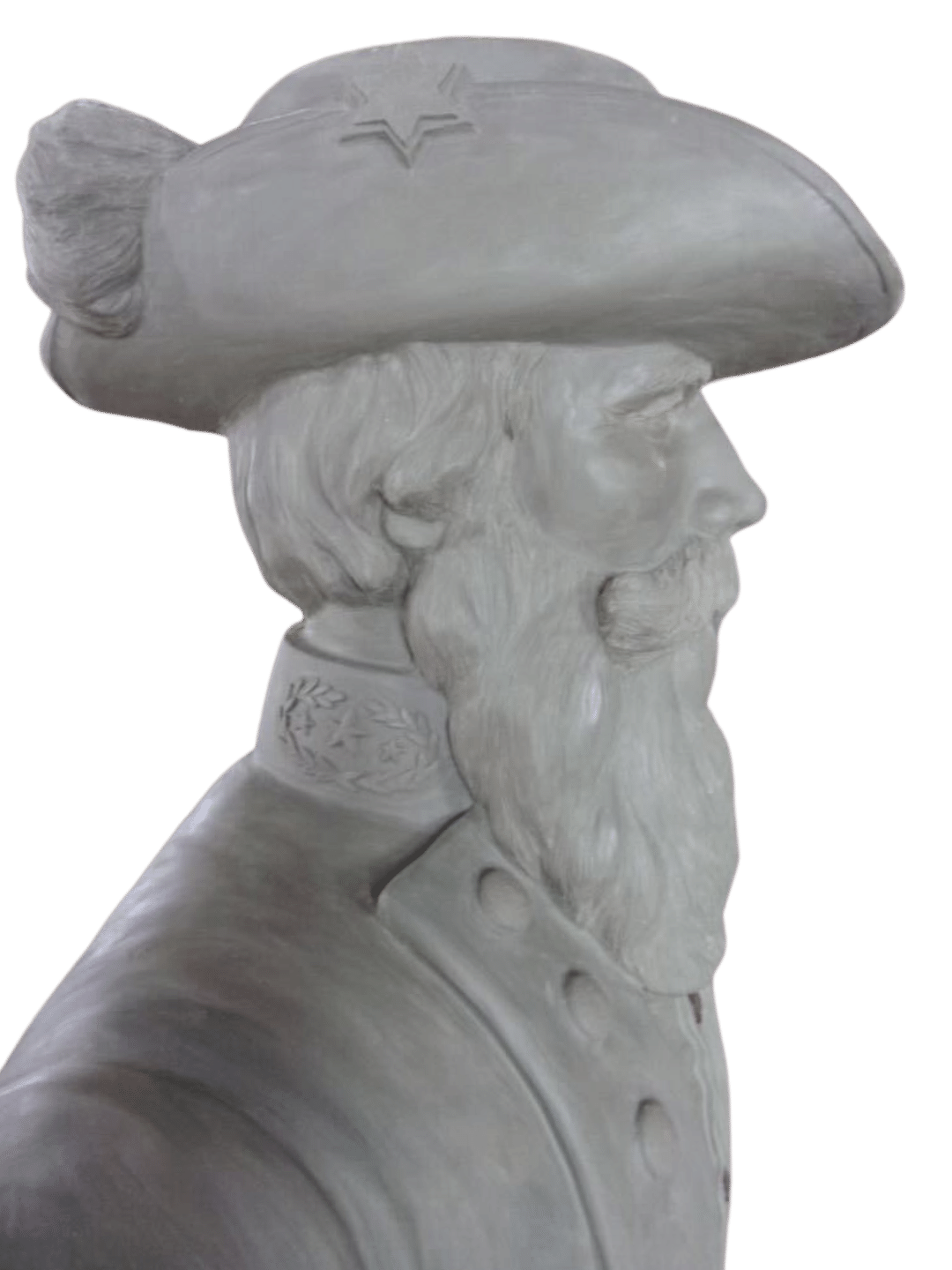 February 6, 1833–May 12, 1864
February 6, 1833–May 12, 1864
Confederate General Jeb Stuart was one of the greatest cavalry commanders in American history.
Early Life
James Ewell Brown Stuart (aka Jeb Stuart) was born on February 6, 1833, at Laurel Hill Farm, his family’s plantation, in Patrick County, Virginia. He was the eighth of eleven children of Archibald Stuart and Elizabeth Letcher Pannill Stuart. Stuart’s great-grandfather, Major Alexander Stuart, was a regimental commander in the Revolutionary War, and his father fought in the War of 1812.
Stuart’s mother schooled her son before having him formally educated by tutors in Wytheville and Danville, Virginia. Between 1848 and 1850, he attended Emory and Henry College in Emory, Virginia.
U.S. Military Academy Cadet
In 1850, United States Congressman Thomas Hamlet Averett nominated Stuart for an appointment to the United States Military Academy. Stuart graduated thirteenth in his class of forty-six cadets in 1854. While attending West Point, Stuart became friends with the academy supervisor and future Confederate army commander, Robert E. Lee.
U.S. Army officer.
After graduating from West Point, officials brevetted Stuart as a second lieutenant and assigned him to the Regiment of Mounted Rifles. Stationed in Texas, he campaigned against the Apache Indians. In 1855, he transferred to the newly formed 1st Cavalry at Fort Leavenworth, Kansas Territory. Shortly after his transfer, Stuart met and married Flora Cooke, the daughter of Lieutenant Colonel Philip St. George Cooke, on November 14, 1855. One month later, on December 20, 1855, Stuart was promoted to first lieutenant. While serving in Kansas, Cheyenne Indians wounded Stuart during a conflict on July 29, 1857.
John Brown’s Raid
In 1859, while visiting Washington, DC, Stuart learned of John Brown’s Raid on the federal arsenal at Harpers Ferry, Virginia. He immediately volunteered to serve as Colonel Robert E. Lee’s aide-de-camp and accompanied Lee to Harpers Ferry to suppress Brown’s insurgents. Colonel Lee sent Stuart under a flag of truce to negotiate surrender with Brown and his followers. When Brown refused, Stuart signaled a company of Marines to storm the engine house where Brown was sequestered. Stuart then took part in Brown’s capture.
War Between the States; Confederate Officer
Promoted to captain on April 22, 1861, Stuart resigned his commission in the United States Army, in early May after his home state of Virginia seceded from the Union on April 17, 1861. On May 10, Virginia officials commissioned Stuart as a lieutenant colonel of the Virginia Infantry in the Confederate Army. They assigned him to serve under Colonel Thomas J. Jackson in General Joseph Johnston‘s Army of the Shenandoah. On July 4, 1861, Jackson placed Stuart in command of the 1st Virginia Cavalry, comprising all cavalry companies of Johnston’s army. Officials promoted Stuart to the rank of colonel two weeks later, on July 16, 1861.
First Battle of Bull Run
Stuart played a prominent role in enabling Johnston’s army to move from the Shenandoah Valley to the vicinity of Manassas in time to reinforce General P. G. T. Beauregard‘s Army of the Potomac at the First Battle of Bull Run (July 21, 1861). Stuart led his regiment during the Confederate victory and the pursuit of the retreating Federals. After the battle, he commanded the army’s outposts along the upper Potomac River until given command of a full cavalry brigade. Confederate officials promoted Stuart to brigadier general on September 24, 1861.
Peninsula Campaign
In 1862, authorities reassigned Stuart to support Johnston’s troops, as federal forces threatened the Confederate capital at Richmond during Major General George B. McClellan‘s Peninsula Campaign. On June 12, Stuart began his famous “Ride around McClellan.” Over the course of three days, he led 1,200 troopers completely around McClellan’s Army of the Potomac on the Virginia Peninsula. Upon his return, he provided strategic information that helped General Robert E. Lee, who had replaced the wounded Johnston. Stuart’s report prompted Lee to launch a counteroffensive that drove the Federals away from Richmond. The flamboyant Stuart’s exploits made him nearly as popular as Stonewall Jackson in the eyes of adoring Southerners.
Army of Northern Virginia Cavalry Commander
On July 25, 1862, officials promoted Stuart to the rank of major general and upgraded his command to a cavalry division. A few weeks later, on August 22, Stuart embarrassed John Pope, commander of the Army of Virginia, by capturing the Union general’s dress uniform and personal baggage, along with $25,000, during a cavalry raid at Catlett’s Station. As a division commander, Stuart took part in the Second Battle of Bull Run (August 28, 1862–August 30, 1862), the Battle of Antietam (September 17, 1862), the Battle of Fredericksburg (December 11–15, 1862), and the Battle of Chancellorsville (April 30-May 6, 1863).
Infantry Commander
During the Battle of Chancellorsville, Stuart temporarily assumed command of Stonewall Jackson’s corps after Jackson received a mortal wound. Under Stuart’s leadership, Jackson’s men forced General Joseph Hooker‘s army to retreat northward across the Rappahannock River.
Battle of Brandy Station
After the Battle of Chancellorsville, Lee launched his second invasion of the north. Stuart returned to his role as a cavalry commander.
On June 9, 1863, Major General Alfred Pleasonton led his Union cavalry corps, augmented by 3,000 infantrymen, in a two-pronged attack to “disperse and destroy” Stuart’s cavalry near Brandy Station, Virginia. Despite being surprised twice on the same day, Stuart’s cavalry prevailed at the Battle of Brandy Station, the largest predominantly cavalry engagement of the Civil War.
Bottom of Form
Gettysburg Campaign
Despite his many successes, Stuart’s failure to advance to Gettysburg in time to be a factor during the first day of that pivotal battle blemished his reputation. Caught behind Union lines, Stuart could not provide Lee with vital intelligence and combat support. As a result, some historians have made Stuart a scapegoat for the Confederate loss at the Battle of Gettysburg (July 1-3, 1863).
Cavalry Corps Commander
Overlooking any shortcomings Stuart may have displayed at Gettysburg, Lee promoted him to the position of corps commander on September 9, 1863. When Confederate fortunes began to decline the following spring, Stuart helped to delay Ulysses S. Grant‘s advance toward Richmond during the Battle of the Wilderness (May 5–7, 1864) and the Battle of Spotsylvania Court House (May 8–21, 1864).
Death
On May 11, 1864, during the Battle of Yellow Tavern, Union Private mortally wounded Stuart with a shot from his .44 caliber revolver while retreating from Stuart’s cavalry. Stuart died the next day, May 12, 1864, at age thirty-one.
The loss of this officer was irreparable, and was keenly felt by General Lee, who in General orders paid the following tribute to his memory:
“Among the gallant soldiers who have fallen in this war, General Stuart was second to none in valor, in zeal and in unfaltering devotion to his country. His achievements form a conspicuous part of the history of this army, with which his name and services will be forever associated. To military capacity of a high order and all the nobler virtues of the soldier he added the brighter graces of a pure life, guided and sustained by the Christian’s faith and hope. The mysterious hand of an all-wise God has removed him from the scene of his usefulness and fame. His grateful countrymen will mourn his loss and cherish his memory. To his comrades in arms he has left the proud recollection of his deeds and his inspiring influence of his example.” R. E. Lee General
Birthdate: February 06, 1833
Birthplace: Patrick County, Virginia, United States
Death: May 12, 1864 (31) Richmond, Virginia, United States (Mortally wounded by a dismounted Federal cavalryman while defending the road to Richmond against Sheridan at Yellow Tavern)
Place of Burial: Hollywood Cemetery, Richmond, Virginia
Immediate Family: Son of Archibald Stuart, US Congress, and Elizabeth Letcher Stuart, Husband of Flora Stuart
Father of Flora Stuart; Captain James Ewell Brown Stuart II and Virginia Pelham Waller
 Introducing the Reverent Jesus Christ Statue: A Testament to Eternal Love and Sacrifice
Introducing the Reverent Jesus Christ Statue: A Testament to Eternal Love and Sacrifice
Crafted with meticulous attention to detail and imbued with profound symbolism, the Jesus Christ Statue stands as a timeless representation of faith, love, and sacrifice. Capturing the essence of Jesus Christ, God the Son, the second person of the Trinity, this exquisitely sculpted statue pays homage to His earthly ministry and eternal divinity.
Born of a virgin and dwelling on earth for thirty-three years, Jesus Christ walked among humanity, teaching, healing, and revealing the boundless love of God the Father. Though He never traversed beyond the boundaries of ancient Palestine and held no worldly power or influence, His impact resonates throughout history, transforming lives for over two millennia.
Central to the statue's depiction is the Most Sacred Heart of Jesus, a revered symbol of God's infinite love for mankind. This devotion, cherished within the Catholic Church and embraced by high church Anglicans and Western Rite Orthodox, celebrates the divine heart of Jesus as a beacon of compassion and redemption.
Intricately designed, the Sacred Heart radiates divine light, symbolizing the fervent love that burns within. Pierced by the lance-wound and encircled by the crown of thorns, it evokes the profound sacrifice of Christ's passion, while the cross atop the heart signifies His ultimate triumph over sin and death.
Every detail of the statue speaks to the profound significance of Christ's life, death, and resurrection. His wounded hands point to the Sacred Heart, directing believers to the source of eternal salvation and unfathomable grace.
Whether adorning sacred spaces, homes, or places of worship, the Jesus Christ Statue serves as a powerful reminder of faith and devotion. It beckons believers to contemplate the enduring message of Christ's love and the promise of His imminent return.
As Revelation 22:20 proclaims, "Even so, come Lord Jesus!" Let the Jesus Christ Statue be a testament to His everlasting presence and boundless love, inspiring hearts and souls for generations to come.
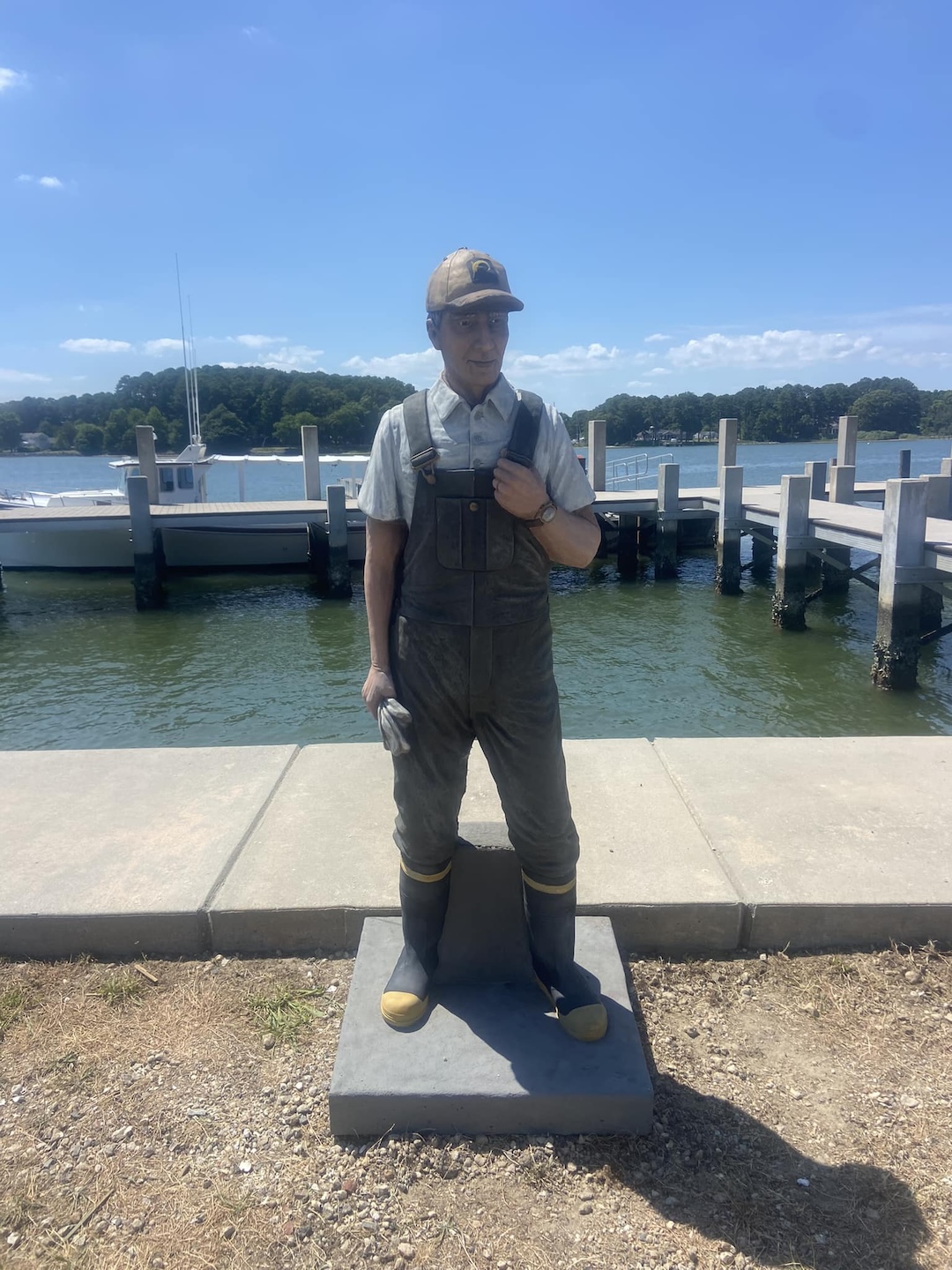 The Chesapeake Bay Watermen are a unique and enduring group of professionals whose livelihoods are deeply intertwined with the waters of the Chesapeake Bay. These individuals, often referred to simply as "watermen," carry on a centuries-old tradition of fishing, crabbing, and oystering in one of America's most productive estuaries. Their work is not only a profession but a way of life, often passed down through generations, and it plays a crucial role in the local economy and culture of the Chesapeake Bay region, particularly around Mathews County, Virginia.
The Chesapeake Bay Watermen are a unique and enduring group of professionals whose livelihoods are deeply intertwined with the waters of the Chesapeake Bay. These individuals, often referred to simply as "watermen," carry on a centuries-old tradition of fishing, crabbing, and oystering in one of America's most productive estuaries. Their work is not only a profession but a way of life, often passed down through generations, and it plays a crucial role in the local economy and culture of the Chesapeake Bay region, particularly around Mathews County, Virginia.
In the Mathews area, watermen engage in a variety of fishing activities. They harvest blue crabs, oysters, clams, and a variety of fish such as striped bass, croaker, and more. This region is known for its rich oyster beds and fertile fishing grounds, making it a hub for seafood enthusiasts. Watermen in Mathews often use traditional methods, such as trotlining for crabs and hand tonging or dredging for oysters, techniques that have been refined over generations. The watermen’s intimate knowledge of the bay's waters, currents, and seasonal patterns is essential for successful harvesting.
The daily routine of a Chesapeake Bay waterman in Mathews begins before dawn. They set out in their deadrise boats, a traditional type of vessel specifically designed for the bay's shallow and choppy waters. Equipped with crab pots, oyster tongs, and fishing nets, they navigate the intricate network of rivers, creeks, and marshes. The work is physically demanding and often involves long hours in varying weather conditions. Their deep connection to the water and the natural resources it provides is a way of life that offers both sustenance and a sense of community.
This demanding work is shaped by the rhythms of the seasons and the tides, as well as by regulations aimed at sustaining the bay's delicate ecosystem. Watermen in Mathews have had to adapt to environmental changes, such as declining oyster populations and pollution, as well as regulatory pressures designed to ensure sustainable fishing practices.
Despite these challenges, the Chesapeake Bay Watermen remain resilient. Their deep connection to the water and the natural resources it provides is reminiscent of the biblical disciples who were called by Jesus while working as fishermen. As Matthew 4:18 states, "For they were fishers," highlighting the timeless nature of this vocation and its significance in human history.
In the face of modern challenges, the watermen continue to embody a spirit of perseverance and adaptability, ensuring that their storied way of life endures for future generations. Their commitment to their craft and to the health of the Chesapeake Bay stands as a testament to the enduring bond between humanity and the natural world. The watermen of Mathews are not just harvesters of the sea but stewards of a rich cultural and environmental heritage, dedicated to preserving the bay's bounty for future generations.
Contact Alcat Cast Stone Art
Give us a call at (804) 505-1203, and be sure to follow us on Facebook for the latest offerings and updates!











